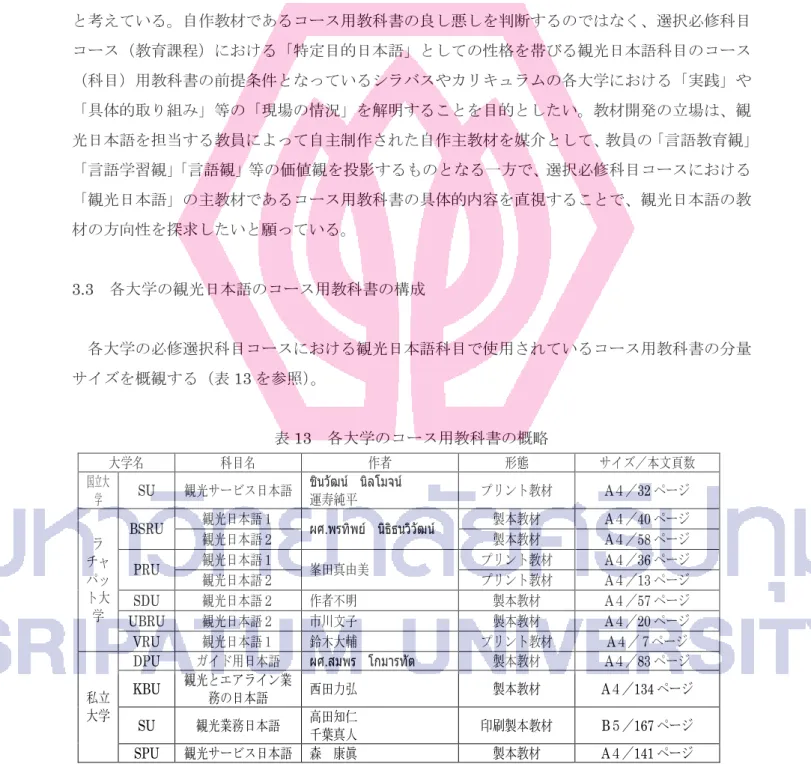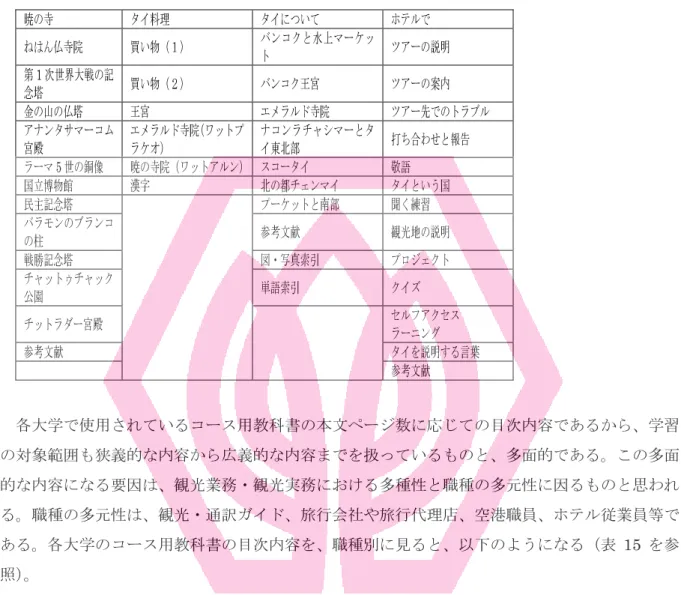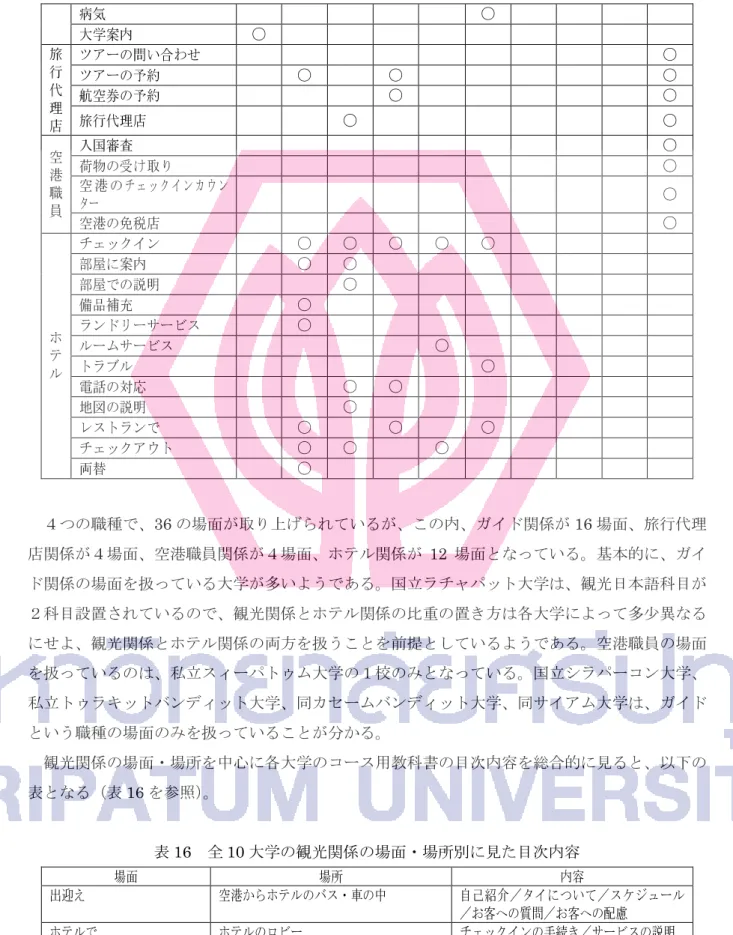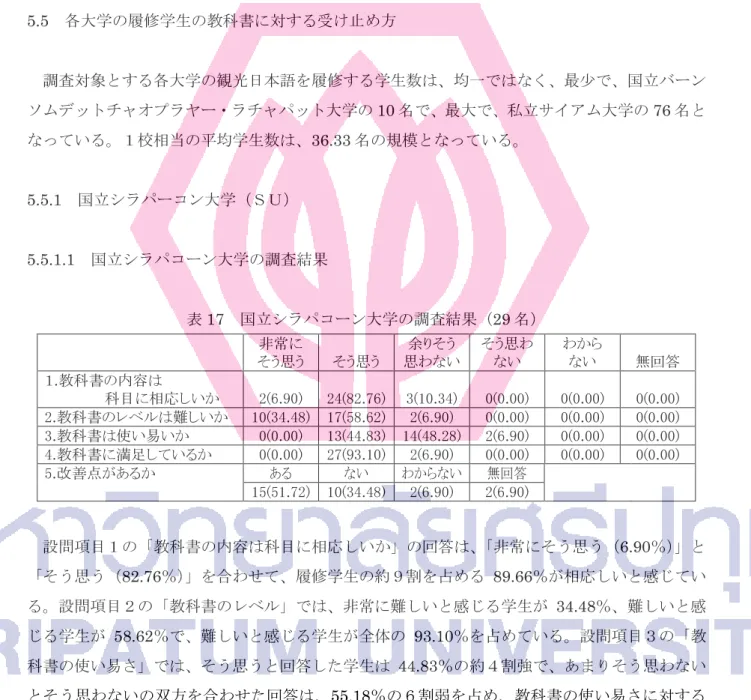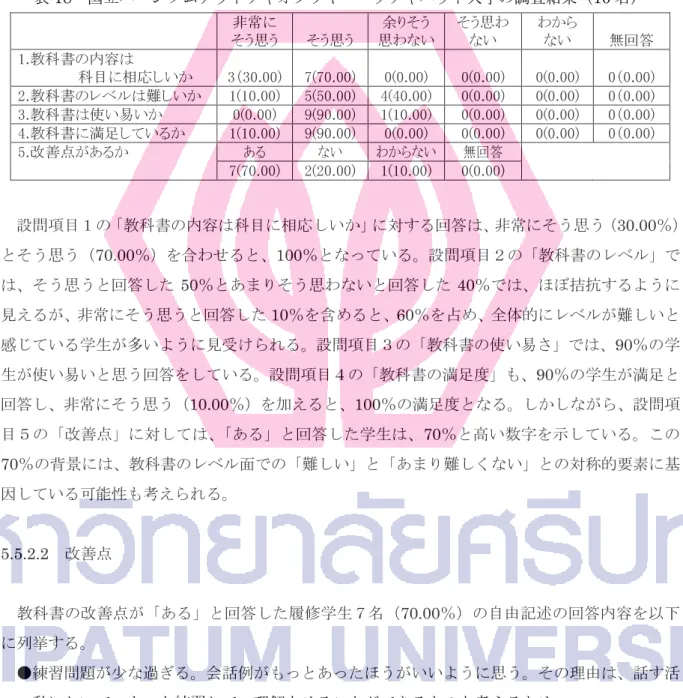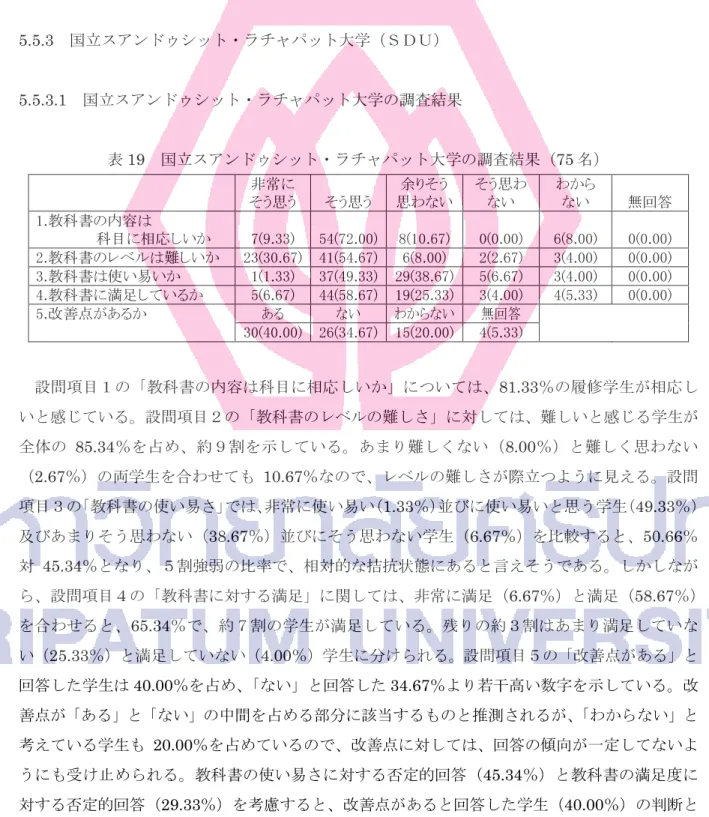「 「 「
「タイ タイ タイ タイ国 国 国 国の の の の大学 大学 大学における 大学 における における日本語 における 日本語 日本語 日本語・ ・ ・ ・選択必修科目 選択必修科目 選択必修科目 選択必修科目コース コース コースの コース の の の『 『 『観光日本語 『 観光日本語 観光日本語』 観光日本語 』 』 』の の の の教材研究 教材研究 教材研究」 教材研究 」 」 」
A STUDY OF JAPANESE FOR TOURISM COMPULSORY COURSE A STUDY OF JAPANESE FOR TOURISM COMPULSORY COURSE A STUDY OF JAPANESE FOR TOURISM COMPULSORY COURSE A STUDY OF JAPANESE FOR TOURISM COMPULSORY COURSE
IN HIGHER EDUCATION IN THAILAND IN HIGHER EDUCATION IN THAILAND IN HIGHER EDUCATION IN THAILAND IN HIGHER EDUCATION IN THAILAND
! "!#$%
森 森 森
森 康 康 康 康 眞 眞 眞 眞
Yasuma Yasuma Yasuma
Yasumasa MORI sa MORI sa MORI sa MORI
仏暦 仏暦 仏暦
仏暦 2551 2551 2551 2551( ( ( ( 2008 2008 2008) 2008 ) ) )年度 年度 年度 年度
第 第 第
第2 2 2期学内教員対象調査研究助成金 2 期学内教員対象調査研究助成金 期学内教員対象調査研究助成金 期学内教員対象調査研究助成金・ ・ ・ ・調査研究 調査研究 調査研究 調査研究プロジェクト プロジェクト プロジェクト報告 プロジェクト 報告 報告書 報告 書 書 書
' (%!)!* #*#
+ 2551 2551 2551 2551 มหาวิทยาลัยศรีปทุม มหาวิทยาลัยศรีปทุม มหาวิทยาลัยศรีปทุม มหาวิทยาลัยศรีปทุม
SRIPATUM UNIVERSITY
刊 刊 刊
刊 行 行 行 行 に に に に 寄 寄 寄 寄 せ せ せ せ て て て て
本調査研究は、筆者が勤務しているタイ国私立スィーパトゥム大学の「学内調査プロジェクト」
として、始められたものである。「学内調査プロジェクト」は、本学の調査研究室が主管する「学 内教員対象調査研究助成金・調査研究プロジェクト」である。本調査研究においては、「仏暦2551
(2008)年度・第2期学内教員対象調査研究助成金・調査研究プロジェクト」として、認可され た公的調査研究となっている。与えられた調査研究の期間は、2009年1月より同年12月までの 1年間と定められた。
想い起こしてみれば、本調査研究プロジェクトの始まりは、2007年4月に遡るかもしれない。
それは、当時、学術関係の学事を担当されていた副学長のニムヌワン・スィーチャード博士(
. .
)の一言から始まったと言える。その「一言」は、筆者に調査研究を「奨める」内容であった。その後、ニムヌワン博士の意を受けた、上記の調査研究室の室長であるピヤコン・
ワンマハーポン博士(
.
)よる説明を受けて、筆者は、調査研究の着手を決断し たのであった。調査研究の計画書の作成・提出及び調査研究報告書の作成・完成に際しては、学 外の有識者を指導主事とする学内の規程もあり、筆者は、本調査研究の表題に最も相応しい専門 家である国立ガセサート大学人文学部外国語学科日本語科に所属するプラニー・チョンスッチャ リットタム準教授(.
)にお願いできる光栄に恵まれた。プラニー準教授は、同大学の日本語学科主任や人文学部副学部長等の重職に就かれた方でもある。ここに、感謝の意 を記したく存じます。筆者の調査研究の能力不足、表題に関する専門的知識の欠如、延いては、
日本語教育の理論的知識に対する理解不足等、忸怩たる思いではある。こうした筆者の力量不足 を補うかの如く、筆者の周辺の方がたのご助言やご協力もいただくことができ、辛うじて、調査 研究の報告書の完成に辿り着けることができた。この場を借りて、改めて、謝辞を関係者の皆様 にお伝えいたしたく存じます。
2010年1月 森 康眞
調査研究の題目 : 「タイ国の大学における日本語・選択必修科目コースの『観光日本語』の教 材研究」
調査研究者名 : 森 康眞
所属機関名 : タイ国私立スィーパトゥム大学教養学部外国語学科
[バンコク バンケーン・キャンパス]
刊行年 : 2009年[B.E.2552]
概 要
本報告書は、タイ国の大学における日本語・選択必修科目コースの「観光日本語」の教材につ いての調査及び研究の成果を記述したものである。そもそも、主専攻課程やこれに準ずる副専攻 課程と異なって、選択必修科目コースにおける日本語履修科目数と履修時間数は、極めて少なく 300時間前後程度である。この限られた制約の中で、「観光日本語」という「特定目的日本語(JSP)」
に鑑みて、「実用的観光日本語」或いは「観光実務に使える日本語」のコース・デザインを考え なければならない現状にある。この現状は、初級レベルの語彙・文法・文型を全体的に網羅する ことなしに、観光実務に応用できる日本語の運用力を養成・向上させなければならない課題を抱 えることになっていると言っても過言ではない。こうした課題に対して、本学と同種の選択必修 型の日本語コースを有する他の大学では、如何なる取り組みと試みがなされているのか、即ち、
各大学の「実践」を調査研究することで、選択必修科目コースにおける「観光日本語」の在り方 や方向性を探ろうというものである。この在り方や方向性を探るべく、調査研究の手順に従って、
1)コース・デザインにおけるコース・シラバス及びコース・カリキュラムの検討、2)シラバ ス及びカリキュラムを具体化した、教育活動の中心を占めるコース用教科書(主教材)として自 主制作された「観光日本語」の自作教材の教材内容の検討、3)自主作成したコース用教科書を 使用して、教室活動を実践している教員へのインタビュー調査、4)コース用教科書に対する「情 意反応」を視るべく、観光日本語を履修する学生へのアンケート調査という方法を用いて、調査 及び記述を進めた。
調査の結果、1)は、観光実務に照らして、実用性や実際に使用される場面・場所・状況を想 定してのシラバスやカリキュラムを優先的に策定している。2)は、担当教員の裁量に任されて いるものの、必要にして、重要な場面でのやりとりに重点を置く、場面シラバスを基軸とする教 材内容となっている。しかしながら、学習レベルの面で、基礎重視、或いは、応用重視のどちら かの立場かによって、語彙・文法・文型の扱い方が異なっている点、実用性の観点からは、待遇
的表現の学習など、工夫を凝らしている点も窺えた。3)は、1)及び2)の動態的側面に該当 する部分であるが、担当教員のシラバス策定能力・教材作成能力・教室活動の創造能力の3点で、
観光実務に必要な語彙・文法・文型・表現の言語知識(言語要素)と言語運用(言語使用)に留 意している姿勢が窺えた。4)は、初級レベルの水準を超えていない履修学生は、科目内容・学 習内容・教科書に対しては満足しているが、学習レベルでは、難しいと判断している結果が得ら れた。
調査結果からは、選択必修科目における「観光日本語」の実情として、「一般目的日本語」と
「特定目的日本語」との比重の掛け方や重点の置き方など、基礎重視か応用重視の学習内容の捉 え方及び学習レベルか目標到達レベルの設定の方法等、依然として、議論を積み重ねる必要性が 認識された。選択必修科目コースにおける「観光日本語」は、担当教員に依存する「現場依存主 義」が浮き彫りになったが、この「現場依存主義」を受け入れた上で、且つ、外国語教育学の「教 材論」の視点を含めた「理念・開発・実践」という枠組みを取り入れることで、筆者は、担当教 員によるシラバスやカリキュラムの再検討、教材の分析・研究・開発に関わる経験的知識と能力、
教室活動の創造能力の可能性が大きな役割を果たすと考える。
その可能性とは、即ち、1)初級レベルの日本語学習の段階から観光実務に応用できる日本語 の語彙・文法・文型を積極的に取り入れる先行的シラバス策定の実践化を図る、2)初級レベル で対応できる、使える観光日本語の実践化を進める、3)観光業務及び実務における使用言語を 調査することで、必要にして求められる言語情報を優先する観光日本語のシラバスを策定化する 作業を推進する、の3点である。指摘された3つの可能性は、将来的方向性に向けて、検討され るべき課題と思われる。
キーワード キーワード キーワード
キーワード: : : :
選択必修科目選択必修科目 観光日本語選択必修科目選択必修科目 観光日本語観光日本語観光日本語 特定目的日本語特定目的日本語特定目的日本語特定目的日本語 シラバスシラバスシラバスシラバス 教材論教材論教材論 教材論Research Title : A Study of Japanese for Tourism compulsory course in Higher Education in Thailand
Name of Researcher : Mr. Yasumasa MORI
Name of Institution : Department of Foreign Languages Faculty of Liberal Arts SRIPATUM UNIVERSITY[Bangkhaen Campus]
Year of Publication : 2009[B.E.2552]
ABSTRACT
This report is a description of investigation and result of study about the teaching material of “Japanese for Tourism” of the selection required subject course at the university in Thailand. To begin with, the selection required subject courses are different from major or minor course in the point with the number of subjects and the time number to be studied are very little, the number is about 300 hours during that time.
In this limited restriction, we should think about the course design of “Practicable Japanese” or “Japanese that can be used for the business in tourism” by paying attention to “Japanese for Specific Purpose (JSP)”
of “Japanese for Tourism”. In this current state, it can be said that it has a problem of having to train and improve the Japanese proficiency that can be applied to the business level without covering the vocabulary, the grammar and the sentence pattern at the beginner's level overall. To such a problem, as for each university with the same course as author’s university, are what approach and the attempt done? That is to say, it searches for these ideal way and directionality of “Japanese for Tourism” in these courses by researching the “Practice” of each university.
According to the procedure of the surveillance study, 1) the examination of the course syllabus and the curriculum in the course design, 2) the examination of the textbook for the course that occupies the center of the educational activity and the textbook for the course are considered as a main material in the teaching material. The content examination of the teaching materials from which independent is produced, 3) the interview survey to the teacher who teaches Japanese Tourism subject with a self-made teaching material.
4) to see “Affect reaction” to the textbook for the course, the questionnaire survey to the student who studied Japanese for Tourism was done.
The research result of 1) the syllabus and the curriculum are made according to the business in consideration of the practicality and the scene, the place, and the situation actually used. 2) though it is left to the charge teacher's discretion, it was a content of the teaching material based on the situational syllabus that emphatically communicated by a necessary and important scene. However, in respect at the study
level, how to treat the vocabulary, the grammar, the sentence pattern are different. As for it, basic abilities emphasis and applied abilities emphasis depend on which standpoint to take. From a practicality viewpoint, each university was exerting their ingenuity in the study of the polite expression. 3) the part of corresponding to the dynamic side of 1) and 2), they are due to 3 points of charge teacher's syllabus decision ability, ability to make teaching material, and creative ability of classroom activity. It was proved that paid attention to the vocabulary, the grammar, the sentence pattern, linguistic knowledge of expression (linguistic factor) and linguistic performance (linguistic use). 4) the student who is not exceeding the level at the beginner's level, the student is satisfying the content of the subject, the content of study, and the textbook. However, they were felt that it was difficult at the study level.
From the research result, as a fact of “Japanese for Tourism” in the selection required subject course, how to balance between “Japanese for general purpose” and “Japanese for specific purpose” or how to give weight of them, how to catch content of study of basic abilities emphasis or applied abilities emphasis, and setting method at study level or target attainment level, it was recognized that it was necessary to pile the discussion in the future. “Japanese for Tourism” in the selection required subject course, it was remarkable that it was “a site dependence principle” that depended on the charge teacher.
After accepting “a site dependence principle” and taking the frame of “idea, development, and practice”
including aspect of “theory on teaching materials” of foreign language pedagogy, the author thought that reexamining the syllabus and the curriculum by charge teacher, empirical knowledge and ability to be related to analysis, research, and development of teaching material, and creative ability and possibility of classroom activity that plays a major role.
The possibilities are 1) to promote the practice of the priori syllabus decision which adopts Japanese vocabulary and grammar and sentence pattern positively to be applied to business from stage at the beginner’s level, 2) to advance practice Japanese for Tourism which is corresponsive to or is usable to the beginner’s level, 3) to promote the decision of syllabus in Japanese for Tourism which gives priority over necessary and demandable language data by researching language used in business. These possibilities seem that it is subject to be examined forward to direction in the future.
Key word Key wordKey word
Key words : s : s : s : selection required subject Japanese for Tourism Japanese for specific selection required subject Japanese for Tourism Japanese for specific selection required subject Japanese for Tourism Japanese for specific selection required subject Japanese for Tourism Japanese for specific purpose syllabus theory on teaching material
purpose syllabus theory on teaching material purpose syllabus theory on teaching material purpose syllabus theory on teaching material
! "
$%
" &"
'$() "* "
.. 2552
! " #"$ #%
&' % ($&"!)* &+", - ""
! .%/*(("-* &"-0 12!
+* & 0%3% ! 0#&%4 300 0% #3-3+ # 7 (,83 4* 3 29&(3*"%$+'7 ('#3*3: 0#%3 ($&"!);& '#3%12#323* & < -
&+'&()3&# : 0#!+$!+ ) '4) * &8*-&0!&# / 12
# ,83 "%2 = >' %:' * &
%&'3'#3+'* 3 ! *( &%2 %:* &- '
#+ %# (1) ("&% "-* &
*2 "8(- (2) ("(+-2!! %
%(=%!%!$32%&"%-2&3>"2 "2'% (3) " %4),83"
.'#3 #+"&"#3( (4) , -3"
&"0#3*"$%$%
#8 !(-
, (1) &% "* &2 "8('#3 #+-" ": 0#4#3!%
2%&"%- ; "$ * &"$4) '3 (2) 2",83""%$
4'#3#3( '9(%2-"", (%0#;&; "$4)+>
* &"+! 3&&% "(%2(4) * &3"""$4)>2 -4&# % 4$&# - !%-3-,83"'%( !,83"!"2&# /%
+23+"!+ ) '4) * &8*-&0!*(( -3( !
*( &%2 '#3+:7 ((!! %&()3 (3) 7 (23-8 3 \
! &% " !%"%$( #"-,83" !%"%$#3, (" * &!%"%$
"3"!)% , "8)2329"
'#3!+$3!+ ) '4) * &8*-&0! %$!%83#3"() (1 #3
"()) * &7 (#3"() (3) (4) '%&"!%"+9
&# /%!%(2- 2 * &(+ *('9(%
%( &&# !-3
, "# +23(3!+$!%2%&"%&2 ($&"!) '
* & ($&"!);& &23+2 ' &+23!%"%$/ * &
+2#:*( &&# 2 %D2% %!%+>&(3%!(
>%*!#"& -8 ( ,83" % /* &*!# * &+'3
%$EF#3""-!8#3(& ,83 %*!#!40!&% "* &
2 "8(! 3!%83 !%"%$-3 !&2) * & <"" * &!%"%$
"3"!) * &!%>''#3-% .%"+!
,83 %-3"*&'3# (1) " "3&% ".!!+ ) '4) * &
8*-&0!&# /."%$+'&()3 '#3!( (2) GHG3
"%$ 3'#3&# / (3) " " #+&% "
23!%"+! -3%8 ! # %&29>"+>0# 3:
-3"*& 3-32 >	!+%4+2#- ('!(
: ($&"!);& &% "
EF""
英文要旨 英文要旨 英文要旨
英文要旨( ( ( ( Summary Summary Summary Summary ) ) ) )
The title of this surveillance study is "Research on Teaching materials of 'Japanese for Tourism' in the required subject course at the universities in Thailand." The composition of the each chapter is as follows:
Introductory chapter "In the beginning"
The introductory chapter described the attitude to author's surveillance study as assumption that advanced this surveillance study. The idea is a basic frame in the surveillance study and an idea of basic how to advance the surveillance study. A basic frame and basic how to advance it were described as a general rule. At least, it aims to clarify author's awareness of the issues to this surveillance study concretely.
Chapter 1 "Whole image in this surveillance study"
Chapter 1 explained a concrete flow and the process of this surveillance study. The description of the background, the purpose, the object, and the method of this surveillance study etc. was advanced. Finally, it somewhat touched the trend of the previous work related to this surveillance study. The explanation of some is added as follows.
The background of this surveillance study has the problem in the system of the required subject of the university where the author works. The problem is in the study time and the academic workload unlike the main major. It is necessary to teach a practicable Japanese level in the limited number of subjects. Author's concern is to look for the method of teaching applied Japanese in little study time. And, it was thought that a Japanese subject of other universities in the required subject course wanted to investigate how to become it. This has relativity also in "Japanese-language education of a general purpose" and "Japanese of the particular purpose". Then, the surveillance study was decided to be advanced by seeing the teaching material of "Japanese related to Tourism" of other universities for the case with Japanese-language education of the required subject course. The problem at the study level is related to the course design, the course syllabus, and the course curriculum. The problem of
the teaching material of "Japanese for Tourism" is deeply related to such a problem. It seems that it is profitable to do the investigation research for the teaching material of "Japanese for Tourism" to understand the reality, the current state, the circumstances and the situation of the required subject course. In this surveillance study, it thought about four approaches. That is, the first approach sees the study target and the content of study of "Japanese for Tourism".
This uses, and examines the outline of the subject of each university. The second approach sees the example of the teaching material of "Japanese for Tourism". The Japanese case used in the teaching material is examined. The third approach is an interview to the teacher who takes charge of "Japanese for Tourism". It is a case with making, development, and the use of the teaching material. The fourth approach is a questionnaire survey to study. The appearance and the attitude of the learner who is studying in the required subject course are examined.
Chapter 2 "Outline of subject of 'Japanese for Tourism' in each university and required subject"
The comparative study of the outline of the subject of "Japanese for Tourism" of the required subject of each university was described and the content was described chiefly. "Course syllabus" used by the course management and "Course Outline", etc. were targeted before comparative study. That is, it is an outline of "Lecture execution outline" of a Japanese related to Tourism at each university subject. Especially, the current state and the tendency to the study item and the content of study are clarified through the comparison analysis of the outline and the study target of the subject. And, it assumes or I think that I can understand the realities of guidance and the content of study that should aim with the target of Japanese for Tourism.
Chapter 3 "'Textbook' at each university as main teaching material of Japanese for Tourism"
The location of the textbook of Japanese for Tourism of each university as the main teaching material was advanced and the analysis of the textbook for the course used at each university was advanced to the aspect. The content of the analysis took a general view of the composition of the textbook, the content of contents of the textbook, and the composition of the content of the division, etc. according to each university. This is called longitudinal method.... The overall observation of the textbook of each university, and the analysis seen
overall were done. The overall analysis is called cross-sectional method.... The example in the textbook for the course of each university was compared overall. Three "Conversation"
based on a common scene, place, situation, and topic to each university based on the analysis result of the textbook was chosen. Three concrete conversation parts are "Meet", "Schedule", and "Explanation and guide of the sightseeing spot." It was tried to search for the feature and the tendency to the textbook for the course as the main teaching material by comparing contrasting the vocabulary, sentence patterns, the expressions, scenes, places, and the situation and topics in three conversations.
Chapter 4 "Interview investigation to teacher who takes charge of Japanese for Tourism subject"
It is to be execution of the interview investigation to the teacher that takes charge of Japanese related to Tourism and explaining of the result of the survey in full. The purpose of the interview investigation is a grasp of the current state of the required subject course that the charge teacher is recognizing (system, subject to be studied code, and subject name etc. of the outline of the system at the time of learning, the condition at the time of learning, the requirement at the time of learning, and the subject to be studied). It is a movement side concerning how to advance the classroom activity using concrete use of the textbook for Tourism and the textbook (how to use of and the teaching material of the syllabus, the curriculum, and the teaching material presence etc. of how to advance the class, the study target, the action target, and the sub-teaching material). It aimed for the situation of guidance and the study of the teacher in the classroom and the learning student to be understood through the above-mentioned hearing survey. It is "Site dependence principle"
realities that depend from the result of the survey to the charge teacher. Three elements (the syllabus curriculum decision ability of the teacher to take charge, the teaching material making ability, and the creation ability of the classroom activity) are included in this "Site dependence principle". These three elements seem a fundamental idea and attitude like knowledge, the ability, and the experience of, etc. practicing teacher's teaching material research, teaching material analysis, and development of teaching materials.
Chapter 5 "Questionnaire survey to learner who studies Japanese for Tourism"
Chapter 5 aimed at the description of a statistical analysis and the consideration of the questionnaire survey to the learner who studied Japanese for Tourism. The purpose of the
questionnaire survey is to total how to catch study to the textbook teaching material of Japanese for Tourism used in the classroom quantitative. The affect reaction to learner's textbook is observed quantitative in total. A statistical analysis was advanced around the analysis of a quantitative result of totaling each university according to each university. The question item made a learner is substantial adaptability of the textbook and the subject, difficulties at the level of the textbook, the easiness of the textbook to use, and is a satisfaction rating to the textbook, and the improvement of the textbook. Of course, the individual variation and the group difference of intercollegiate each are seen as for the answer to five questions. It seems that this originates in the difference of the interpretive criterion of the content of the question of the learner. The tendency to an affect reaction to learner's textbook, the situation, and the state were stopped understanding visible to the last.
It seems that the learner was able to clarify the extent with what idea and the judgment, the guess, the opinion, and the sense of the textbook in the numerical value.
Chapter 6 "The entire summary"
It looks back on Chapter 6 again on the description and the content sides in each chapter from the introductory chapter to Chapter 5. And, the analysis, the result, and the consideration that had been obtained for this case investigation were brought together overall, and overall.
In respect of the quality and the amount, through the teaching material, there is
"Temperature difference" of intercollegiate, too. This is a difference among the main major, the sub-major(or minor), and the required subject course, and it can be said, "Climate difference". Next, "Temperature difference" in respect of charge teacher's nature, ability, and aptitude can be pointed out. After that, there is "Temperatures fluctuate" in the required subject course, too. These "Difference" has the reality that becomes severe "Natural condition". As for this severe "Natural condition", not only the course design, the course syllabus, and the course curriculum but also various abilities concerning the teaching material of the teacher are asked. It is urged by the necessity putting out the maximum effect in this severe "Natural condition". The existence value of the textbook shows the importance of the teaching material theory. The textbook for the course of "Japanese for Tourism" of the required subject course is also the same. Therefore, it wants to make "Teaching material theory" in the foreign language pedagogy a starting point, to confirm what should be of the teaching material research, the teaching material analysis, and the development of teaching
materials again, and to allot it to the entire summary.
"Teaching material theory" in the foreign language pedagogy has an important function to connect the course syllabus with the course curriculum in the course design. It is thought that it wants to try to catch "Teaching material" where it is existence of the educational activity intermediate middle mental from three aspects of "Idea", "Development", and
"Practice".
"Idea" means "Teaching material theory" in the entire course. It is a thought part of a guideline of the educational institution, an educational concept, an educational system, and the curriculum. It relates to an idea and the directionality of the development of teaching materials.
A series of work process of the preparation for the teaching material, making, and the decision is indicated from the standpoint of "Development" by the one that "Idea" was materialized. Especially, the disproportion at the study level and the attainment level is pointed out in the required subject course. There is a problem of linguistic competence and the linguistic performance, too. Linguistic competence is the acquisition of the vocabulary, the grammar, the sentence pattern, and the expression, etc., and the linguistic performance is training and improvements of the running communications skills as for the integration of the language skill. Two standpoints of a basic valuing and the application valuing are thought by how to put the reference point at the study level and the attainment level. Each university is sure to take pains, to be anxious, and to exist in the current state in which it makes an effort about either in how to multiply the specific gravity of how to put it or a basic valuing and the application valuing of the specific gravity at the study level and the attainment level in the required subject course.
It can be said that "Practice" is a teaching material theory of which the aspect who the teacher and is the learner. As for "Teaching material" that "Development" is done on the assumption of "Idea", the real value is asked in "Practice" in the classroom. True value of the teaching material that reflects the syllabus and the curriculum receives the evaluation by the teacher and the learner. "Practice" seems for the evaluation to the running teaching material to be feedback to not only teacher's teaching material development ability but also "Idea" of the educational institution, and to contribute to the system, the plan, continuance, and the stability of the entire course. Literally, the triangular position at the circulation cycle "⇒ idea ⇒ development ⇒ practice ⇒".
Closing chapter "Ending"
It meant the examination of "Investigation", and the idea of "Research", and the author advanced the surveillance study dividing into the standpoint where this two were separated and the uniting standpoint. Researched pronunciation to "Fact" collected by the investigation was done. However, the examination is required about the validity of the methodology.
Moreover, the conclusion and completeness might be lacked for the consideration of the result of the survey and the conclusion of research results. I want to expect the discussion in the future.
By the way, the main major course and the sub-major course are made a main current as for Japanese-language education of the university in Thailand, and the required subject type course is thought to be a by the side style and branch location. It seems that by the side and branch courses in this required subject course have originality. The author might have been looking for the judging material that pursued this. It seems to match not only author's empirical fact but also other teachers' empirical facts, and it to be extremely in the trial and error stage "Japanese for Tourism" of a present required subject course. It is thought creative instability to the future with the side where a fluid element is strong. Still, it is needless to say that the teacher on the site is needed to discuss and to examine. An impatient conclusion need not be requested. The advancing idea seems to be good because it progresses gradually little by little aiming at the idea and the ideal. It is necessary to obtain "Consent" somehow...
The author wants to be working like bearing the surveillance study where the teacher's experience can be shared in mind through the accumulation of information, systematization, and accumulation and the systematization of the experience in the future.
Finally, I wish to express my gratitude to everybody of parties concerned who cooperated in the author's research investigation.
タイ タイ
タイ タイ国 国 国 国の の の大学 の 大学 大学における 大学 における における における日本語 日本語 日本語 日本語・ ・ ・ ・選択必修科目 選択必修科目 選択必修科目 選択必修科目コース コース コース コースの の の の「 「 「観光日本語 「 観光日本語 観光日本語」 観光日本語 」 」 」の の の教材研究 の 教材研究 教材研究 教材研究
目 目 目 目 次 次 次 次
刊行 刊行 刊行
刊行に に に に寄 寄 寄 寄せて せて せて せて・・・・・・・・・・・・・・・・・・・・・・・・・・・・・ ・・・・・・・・・・・・・・・・・・・・・・・・・・・・・ ・・・・・・・・・・・・・・・・・・・・・・・・・・・・・ ・・・・・・・・・・・・・・・・・・・・・・・・・・・・・
ⅲ和文概要
和文概要 和文概要
和文概要・・・・・・・・・・・・・・・・・・・・・・・・・・・・・・・ ・・・・・・・・・・・・・・・・・・・・・・・・・・・・・・・ ・・・・・・・・・・・・・・・・・・・・・・・・・・・・・・・ ・・・・・・・・・・・・・・・・・・・・・・・・・・・・・・・ ⅴ 英文概要
英文概要 英文概要
英文概要・・・・・・・・・・・・・・・・・・・・・・・・・・・・・・・ ・・・・・・・・・・・・・・・・・・・・・・・・・・・・・・・ ・・・・・・・・・・・・・・・・・・・・・・・・・・・・・・・ ・・・・・・・・・・・・・・・・・・・・・・・・・・・・・・・ ⅶ タイ タイ タイ
タイ文概要 文概要 文概要 文概要・・・・・・・・・・・・・・・・・・・・・・・・・・・・・・ ・・・・・・・・・・・・・・・・・・・・・・・・・・・・・・ ・・・・・・・・・・・・・・・・・・・・・・・・・・・・・・ ・・・・・・・・・・・・・・・・・・・・・・・・・・・・・・ ⅸ 英文 英文 英文
英文要旨 要旨 要旨 要旨・・・・・・・・・・・・・・・・・・・・・・・・・・・・ ・・・・・・・・・・・・・・・・・・・・・・・・・・・・ ・・・・・・・・・・・・・・・・・・・・・・・・・・・・ ・・・・・・・・・・・・・・・・・・・・・・・・・・・・・・・ ・・・ ・・・ ・・・ xi
目次 目次 目次
目次・・・・・・・・・・・・・・・・・・・・・・・・・・・・・・・・・ ・・・・・・・・・・・・・・・・・・・・・・・・・・・・・・・・・ ・・・・・・・・・・・・・・・・・・・・・・・・・・・・・・・・・ ・・・・・・・・・・・・・・・・・・・・・・・・・・・・・・・・・
xⅸ序章 序章 序章
序章 はじめに はじめに はじめに はじめに
・・・・・・・・・・・・・・・・・・・・・・・・・・・・・・・・・・・・・・・・・・・・・・・・・・・・・・・・・・・・・・・・・・・・・・・・・・・・・・・・・・・・・・・・・・・・・・・・・・・・・・・・・・・・・・・・・・・・・・・・・・・・ 27 0.1 調査研究の基本的枠組み・・・・・・・・・・・・・・・・・・・・・・・・・ 29 0.2 調査研究の基本的進め方・・・・・・・・・・・・・・・・・・・・・・・・・ 29 0.3 調査研究の表題と使用言語・・・・・・・・・・・・・・・・・・・・・・・・ 30第 第 第
第1 1 1 1章 章 章 章 本調査研究 本調査研究 本調査研究 本調査研究の の の の全体像 全体像 全体像 全体像
・・・・・・・・・・・・・・・・・・・・・・・・・・・・・・・・・・・・・・・・・・・・・・・・・・・・・・・・・・・・・・・・・・・・・・・・・・・・・・・・・・・・・・・・・・・・・・・・ 31 1.1 本調査研究の背景・・・・・・・・・・・・・・・・・・・・・・・・・・・・ 33 1.2 本調査研究の目的・・・・・・・・・・・・・・・・・・・・・・・・・・・・ 35 1.3 本調査研究の対象・・・・・・・・・・・・・・・・・・・・・・・・・・・・ 36 1.4 本調査研究の方法・・・・・・・・・・・・・・・・・・・・・・・・・・・・ 401.4.1 観光関連科目の履修科目の概要・・・・・・・・・・・・・・・・・・・・ 40
1.4.2 観光関連科目の教科書の検討・・・・・・・・・・・・・・・・・・・・・ 41
1.4.3 観光関連科目を担当する教員への面接調査・・・・・・・・・・・・・・・ 41
1.4.4 観光関連科目を履修する学生へのアンケート調査・・・・・・・・・・・・ 41
1.5 本調査研究に関連する先行研究の動向・・・・・・・・・・・・・・・・・・・ 41
1.5.1 タイ国内の研究会の動向・・・・・・・・・・・・・・・・・・・・・・・ 42
1.5.2 タイ国内の学術刊行物の動向・・・・・・・・・・・・・・・・・・・・・ 44
第 第 第
第2 2 2 2章 章 章 章 各大学 各大学 各大学 各大学・ ・ ・選択必修科目 ・ 選択必修科目 選択必修科目 選択必修科目における における における における「 「 「 「観光日本語 観光日本語 観光日本語」 観光日本語 」 」 」の の の科目概要 の 科目概要 科目概要 科目概要
・・・・・・・・・・・・・・・・・・・・ 45 2.1 「観光日本語」科目の概要・・・・・・・・・・・・・・・・・・・・・・・・ 47 2.2 各大学の「観光日本語」科目の概要・・・・・・・・・・・・・・・・・・・・ 472.2.1 国立シラパーコン大学(ペッチャブリー県・ITキャンパス)・・・・・・・ 48
2.2.2 国立バーンソムデットチャオプラヤー・ラチャパット大学・・・・・・・・ 49
2.2.3 国立プラナコン・ラチャパット大学・・・・・・・・・・・・・・・・・・ 50
2.2.4 国立スアンドゥシット・ラチャパット大学(フアヒン・キャンパス)・・・・ 53
2.2.5 国立ウボンラーチャターニー・ラチャパット大学・・・・・・・・・・・・ 54
2.2.6 国立ワライヤロンコン・ラチャパット大学・・・・・・・・・・・・・・・ 55
2.2.7 私立トゥラキットバンディット大学・・・・・・・・・・・・・・・・・・ 56
2.2.8 私立カセームバンディット大学・・・・・・・・・・・・・・・・・・・・ 57
2.2.9 私立サイアム大学・・・・・・・・・・・・・・・・・・・・・・・・・・ 58
2.2.10 私立スィーパトゥム大学(バンケーン・キャンパス)・・・・・・・・・・ 59
2.3 「コース・アウトライン」の全体的傾向と個別的傾向・・・・・・・・・・・・ 60
2.3.1 観光日本語科目の名称・・・・・・・・・・・・・・・・・・・・・・・・ 60
2.3.2 観光日本語科目の概要・・・・・・・・・・・・・・・・・・・・・・・・ 61
2.3.3 観光日本語科目の学習目標・・・・・・・・・・・・・・・・・・・・・・ 62
2.3.4 観光日本語科目の学習内容の項目・・・・・・・・・・・・・・・・・・・ 65
2.3.5 観光日本語科目のテキスト・教材・参考図書・・・・・・・・・・・・・・ 68
第 第 第
第3 3 3 3章 章 章 章 各大学 各大学 各大学 各大学における における における観光日本語 における 観光日本語 観光日本語 観光日本語の の の の主教材 主教材 主教材 主教材としての としての としての「 としての 「 「 「教科書 教科書 教科書」 教科書 」 」 」
・・・・・・・・・・・・・・・・・・・・・・・・ 71 3.1 「教科書」の定義・・・・・・・・・・・・・・・・・・・・・・・・・・・・ 733.1.1 教材と教科書・・・・・・・・・・・・・・・・・・・・・・・・・・・・ 73
3.1.2 主教材とコース用教科書・・・・・・・・・・・・・・・・・・・・・・・ 73
3.1.3 自主制作教材とコース用教科書・・・・・・・・・・・・・・・・・・・・ 74
3.2 各大学の観光日本語のコース用教科書の教科書分析・・・・・・・・・・・・・ 74 3.3 各大学の観光日本語のコース用教科書の構成・・・・・・・・・・・・・・・・ 75 3.4 各大学の観光日本語のコース用教科書の目次・・・・・・・・・・・・・・・・ 76
3.4.1 国立シラパーコン大学(SU)・・・・・・・・・・・・・・・・・・・・・ 76
3.4.2 国立バーンソムデットチャオプラヤー・ラチャパット大学(BSRU)・・・・ 77
3.4.3 国立プラナコン・ラチャパット大学(PRU)・・・・・・・・・・・・・・ 77
3.4.4 国立スアンドゥシット・ラチャパット大学(SDU)・・・・・・・・・・・ 77
3.4.5 国立ウボンラーチャターニー・ラチャパット大学(UBRU)・・・・・・・ 78
3.4.6 国立ワライヤロンコン・ラチャパット大学(VRU)・・・・・・・・・・・ 78
3.4.7 私立トゥラキットバンディット大学(DPU)・・・・・・・・・・・・・・ 78
3.4.8 私立カセームバンディット大学(KBU)・・・・・・・・・・・・・・・・ 79
3.4.9 私立サイアム大学(SU)・・・・・・・・・・・・・・・・・・・・・・・ 79
3.4.10 私立スィーパトゥム大学(SPU)・・・・・・・・・・・・・・・・・・・ 80
3.5 各大学における観光日本語・コース用教科書の目次の全体的概観・・・・・・・ 80
3.6 各大学の観光日本語のコース用教科書の内容構成・・・・・・・・・・・・・・ 84
3.6.1 出迎え・・・・・・・・・・・・・・・・・・・・・・・・・・・・・・・ 84
3.6.1.1 国立シラパーコン大学・・・・・・・・・・・・・・・・・・・・・・ 84 3.6.1.2 国立プラナコン・ラチャパット大学・・・・・・・・・・・・・・・・ 86 3.6.1.3 国立スアンドゥシット・ラチャパット大学・・・・・・・・・・・・・ 86 3.6.1.4 国立ウボンラーチャターニー・ラチャパット大学・・・・・・・・・・ 87 3.6.1.5 国立ワライヤロンコン・ラチャパット大学・・・・・・・・・・・・・ 88 3.6.1.6 私立トゥラキットバンディット大学・・・・・・・・・・・・・・・・ 89 3.6.1.7 私立カセームバンディット大学・・・・・・・・・・・・・・・・・・ 90 3.6.1.8 私立サイアム大学・・・・・・・・・・・・・・・・・・・・・・・・ 91 3.6.1.9 私立スィーパトゥム大学・・・・・・・・・・・・・・・・・・・・・ 92
3.6.2 スケジュール・・・・・・・・・・・・・・・・・・・・・・・・・・・・ 93
3.6.2.1 国立バーンソムデットチャオプラヤー・ラチャパット大学・・・・・・ 93 3.6.2.2 国立プラナコン・ラチャパット大学・・・・・・・・・・・・・・・・ 94 3.6.2.3 国立スアンドゥシット・ラチャパット大学・・・・・・・・・・・・・ 95 3.6.2.4 国立ウボンラーチャターニー・ラチャパット大学・・・・・・・・・・ 96 3.6.2.5 私立トゥラキットバンディット大学・・・・・・・・・・・・・・・・ 96 3.6.2.6 私立カセームバンディット大学・・・・・・・・・・・・・・・・・・ 98 3.6.2.7 私立サイアム大学・・・・・・・・・・・・・・・・・・・・・・・・ 98 3.6.2.8 私立スィーパトゥム大学・・・・・・・・・・・・・・・・・・・・・ 99
3.6.3 観光地の説明・案内・・・・・・・・・・・・・・・・・・・・・・・・・ 100
3.6.3.1 国立バーンソムデットチャオプラヤー・ラチャパット大学・・・・・・ 101 3.6.3.2 国立プラナコン・ラチャパット大学・・・・・・・・・・・・・・・・ 102 3.6.3.3 国立スアンドゥシット・ラチャパット大学・・・・・・・・・・・・・ 102 3.6.3.4 国立ウボンラーチャターニー・ラチャパット大学・・・・・・・・・・ 103 3.6.3.5 私立カセームバンディット大学・・・・・・・・・・・・・・・・・・ 104 3.6.3.6 私立サイアム大学・・・・・・・・・・・・・・・・・・・・・・・・ 105 3.7 共通する3場面の文法・文型・表現・・・・・・・・・・・・・・・・・・・・ 106
3.7.1 出迎えの場面・・・・・・・・・・・・・・・・・・・・・・・・・・・・ 106
3.7.1.1 文法・文型・・・・・・・・・・・・・・・・・・・・・・・・・・・ 107 3.7.1.2 表現・・・・・・・・・・・・・・・・・・・・・・・・・・・・・・ 108
3.7.2 スケジュールの場面・・・・・・・・・・・・・・・・・・・・・・・・・ 109
3.7.2.1 文法・文型・・・・・・・・・・・・・・・・・・・・・・・・・・・ 109
3.7.2.2 表現・・・・・・・・・・・・・・・・・・・・・・・・・・・・・・ 110
3.7.3 観光地の説明・案内の場面・・・・・・・・・・・・・・・・・・・・・・ 110
3.7.3.1 文法・文型・・・・・・・・・・・・・・・・・・・・・・・・・・・ 111 3.7.3.2 表現・・・・・・・・・・・・・・・・・・・・・・・・・・・・・・ 112
3.7.4 各大学のコース用教科書の特徴・・・・・・・・・・・・・・・・・・・・ 112
3.8 観光日本語のコース用教科書に求められるもの・・・・・・・・・・・・・・・ 113
第 第 第
第4 4 4 4章 章 章 章 観光日本語科目 観光日本語科目 観光日本語科目 観光日本語科目を を を を担当 担当 担当する 担当 する する する教員 教員 教員 教員への への への へのインタビュー インタビュー インタビュー調査 インタビュー 調査 調査 調査
・・・・・・・・・・・・・・・・・・・・・・・・・・・・ 115 4.1 インタビュー調査の目的・・・・・・・・・・・・・・・・・・・・・・・・・ 117 4.2 インタビュー調査の方法・・・・・・・・・・・・・・・・・・・・・・・・・ 117 4.3 インタビュー調査の質問内容・・・・・・・・・・・・・・・・・・・・・・・ 117 4.4 インタビュー調査の対象者・実施日・実施地・・・・・・・・・・・・・・・・ 1174.4.1 国立シラパーコン大学(ペッチャブリー県・ITキャンパス)・・・・・・・ 117
4.4.2 国立バーンソムデットチャオプラヤー・ラチャパット大学・・・・・・・・ 118
4.4.3 国立プラナコン・ラチャパット大学・・・・・・・・・・・・・・・・・・ 118
4.4.4 国立スアンドゥシット・ラチャパット大学(フアヒン・キャンパス)・・・・ 118
4.4.5 国立ウボンラーチャターニー・ラチャパット大学・・・・・・・・・・・・ 118
4.4.6 国立ワライヤロンコン・ラチャパット大学・・・・・・・・・・・・・・・ 118
4.4.7 私立トゥラキットバンディット大学・・・・・・・・・・・・・・・・・・ 119
4.4.8 私立カセームバンディット大学・・・・・・・・・・・・・・・・・・・・ 119
4.4.9 私立サイアム大学・・・・・・・・・・・・・・・・・・・・・・・・・・ 119
4.4.10 私立スィーパトゥム大学(バンコク・バンケーン・キャンパス)・・・・・ 119
4.5 各大学の観光日本語科目を担当する教員へのインタビュー結果・・・・・・・・ 119
4.5.1 国立シラパーコン大学・・・・・・・・・・・・・・・・・・・・・・・・ 119
4.5.1.1 日本語コース全体の履修制度・・・・・・・・・・・・・・・・・・・ 120 4.5.1.2 観光日本語に関わる科目・・・・・・・・・・・・・・・・・・・・・ 120
4.5.2 国立バーンソムデットチャオプラヤー・ラチャパット大学・・・・・・・・ 121
4.5.2.1 日本語コース全体の履修制度・・・・・・・・・・・・・・・・・・・ 121 4.5.2.2 観光日本語に関わる科目・・・・・・・・・・・・・・・・・・・・・ 122
4.5.3 国立プラナコン・ラチャパット大学・・・・・・・・・・・・・・・・・・ 123
4.5.3.1 日本語コース全体の履修制度・・・・・・・・・・・・・・・・・・・ 123 4.5.3.2 観光日本語に関わる科目・・・・・・・・・・・・・・・・・・・・・ 124
4.5.4 国立スアンドゥシット・ラチャパット大学・・・・・・・・・・・・・・・ 125
4.5.4.1 日本語コース全体の履修制度・・・・・・・・・・・・・・・・・・・ 125
4.5.4.2 観光日本語に関わる科目・・・・・・・・・・・・・・・・・・・・・ 125
4.5.5 国立ウボンラーチャターニー・ラチャパット大学・・・・・・・・・・・・ 126
4.5.5.1 日本語コース全体の履修制度・・・・・・・・・・・・・・・・・・・ 126 4.5.5.2 観光日本語に関わる科目・・・・・・・・・・・・・・・・・・・・・ 127
4.5.6 国立ワライヤロンコン・ラチャパット大学・・・・・・・・・・・・・・・ 128
4.5.6.1 日本語コース全体の履修制度・・・・・・・・・・・・・・・・・・・ 128 4.5.6.2 観光日本語に関わる科目・・・・・・・・・・・・・・・・・・・・・ 128
4.5.7 私立トゥラキットバンディット大学・・・・・・・・・・・・・・・・・・ 129
4.5.7.1 日本語コース全体の履修制度・・・・・・・・・・・・・・・・・・・ 129 4.5.7.2 観光日本語に関わる科目・・・・・・・・・・・・・・・・・・・・・ 130
4.5.8 私立カセームバンディット大学・・・・・・・・・・・・・・・・・・・・ 131
4.5.8.1 日本語コース全体の履修制度・・・・・・・・・・・・・・・・・・・ 131 4.5.8.2 観光日本語に関わる科目・・・・・・・・・・・・・・・・・・・・・ 131
4.5.9 私立サイアム大学・・・・・・・・・・・・・・・・・・・・・・・・・・ 132
4.5.9.1 日本語コース全体の履修制度・・・・・・・・・・・・・・・・・・・ 132 4.5.9.2 観光日本語に関わる科目・・・・・・・・・・・・・・・・・・・・・ 133
4.5.10 私立スィーパトゥム大学・・・・・・・・・・・・・・・・・・・・・・ 134
4.5.10.1 日本語コース全体の履修制度・・・・・・・・・・・・・・・・・・ 134 4.5.10.2 観光日本語に関わる科目・・・・・・・・・・・・・・・・・・・・ 135 4.6 観光日本語を担当する教員の置かれている現状・・・・・・・・・・・・・・ 136
4.6.1 シラバス・カリキュラムの策定能力・・・・・・・・・・・・・・・・・・ 136
4.6.2 教材作成能力・・・・・・・・・・・・・・・・・・・・・・・・・・・・ 137
4.6.3 教室活動の創造能力・・・・・・・・・・・・・・・・・・・・・・・・・ 137
4.6.4 教員の教材研究・教材分析・教材開発の向上を目指して・・・・・・・・・ 137
第 第 第
第5 5 5 5章 章 章 章 観光日本語 観光日本語 観光日本語 観光日本語を を を を履修 履修 履修 履修する する する学習者 する 学習者 学習者 学習者への への への へのアンケート アンケート アンケート調査 アンケート 調査 調査 調査
・・・・・・・・・・・・・・・・・・・・・・・・・・・・・・・・・・・・ 139 5.1 アンケート調査の目的・・・・・・・・・・・・・・・・・・・・・・・・・・ 141 5.2 アンケート調査の実施方法・・・・・・・・・・・・・・・・・・・・・・・・ 141 5.3 アンケート調査の形式と内容・・・・・・・・・・・・・・・・・・・・・・・ 141 5.4 アンケート調査の対象者・・・・・・・・・・・・・・・・・・・・・・・・・ 141 5.5 各大学の履修学生の教科書に対する受け止め方・・・・・・・・・・・・・・・ 1425.5.1 国立シラパーコン大学(SU)・・・・・・・・・・・・・・・・・・・・・ 142
5.5.1.1 国立シラパーコン大学の調査結果・・・・・・・・・・・・・・・・・ 142 5.5.1.2 改善点・・・・・・・・・・・・・・・・・・・・・・・・・・・・・ 143
5.5.2 国立バーンソムデットチャオプラヤー・ラチャパット大学(BSRU)・・・・ 144 5.5.2.1 国立バーンソムデットチャオプラヤー・ラチャパット大学の調査結果・ 144 5.5.2.2 改善点・・・・・・・・・・・・・・・・・・・・・・・・・・・・・ 144
5.5.3 国立スアンドゥシット・ラチャパット大学(SDU)・・・・・・・・・・・ 145
5.5.3.1 国立スアンドゥシット・ラチャパット大学の調査結果・・・・・・・・ 145 5.5.3.2 改善点・・・・・・・・・・・・・・・・・・・・・・・・・・・・・ 146
5.5.4 国立ウボンラーチャターニー・ラチャパット大学・・・・・・・・・・・・ 146
5.5.4.1 国立ウボンラーチャターニー・ラチャパット大学の調査結果・・・・・ 146 5.5.4.2 改善点・・・・・・・・・・・・・・・・・・・・・・・・・・・・・ 147
5.5.5 国立ワライヤロンコン・ラチャパット大学(VRU)・・・・・・・・・・・ 147
5.5.5.1 国立ワライヤロンコン・ラチャパット大学の調査結果・・・・・・・・ 148 5.5.5.2 改善点・・・・・・・・・・・・・・・・・・・・・・・・・・・・・ 148
5.5.6 私立トゥラキットバンディット大学(DPU)・・・・・・・・・・・・・・ 148
5.5.6.1 私立トゥラキットバンディット大学の調査結果・・・・・・・・・・・ 148 5.5.6.2 改善点・・・・・・・・・・・・・・・・・・・・・・・・・・・・・ 149
5.5.7 私立カセームバンディット大学(KBU)・・・・・・・・・・・・・・・・ 150
5.5.7.1 私立カセームバンディット大学の調査結果・・・・・・・・・・・・・ 150 5.5.7.2 改善点・・・・・・・・・・・・・・・・・・・・・・・・・・・・・ 151
5.5.8 私立サイアム大学(SU)・・・・・・・・・・・・・・・・・・・・・・・ 151
5.5.8.1 私立サイアム大学の調査結果・・・・・・・・・・・・・・・・・・・ 151 5.5.8.2 改善点・・・・・・・・・・・・・・・・・・・・・・・・・・・・・ 152
5.5.9 私立スィーパトゥム大学(SPU)・・・・・・・・・・・・・・・・・・・ 153
5.5.9.1 私立スィーパトゥム大学の調査結果・・・・・・・・・・・・・・・・ 153 5.5.9.2 改善点・・・・・・・・・・・・・・・・・・・・・・・・・・・・・ 154 5.5.10 9大学・履修学生の全体的傾向・・・・・・・・・・・・・・・・・・ 154 5.6 項目別に見た各大学の履修学生の受け止め方・・・・・・・・・・・・・・・・ 155
5.6.1 教科書の内容は相応しいか・・・・・・・・・・・・・・・・・・・・・・ 156
5.6.2 教科書のレベルは難しいか・・・・・・・・・・・・・・・・・・・・・・ 157
5.6.3 教科書は使い易いか・・・・・・・・・・・・・・・・・・・・・・・・・ 158
5.6.4 教科書に満足しているか・・・・・・・・・・・・・・・・・・・・・・・ 159
5.6.5 改善点があるか・・・・・・・・・・・・・・・・・・・・・・・・・・・ 160
5.6.6 補論・・・・・・・・・・・・・・・・・・・・・・・・・・・・・・・・ 161
第 第 第
第6 6 6 6章 章 章 章 全体 全体 全体 全体のまとめ のまとめ のまとめ のまとめ
・・・・・・・・・・・・・・・・・・・・・・・・・・・・・・・・・・・・・・・・・・・・・・・・・・・・・・・・・・・・・・・・・・・・・・・・・・・・・・・・・・・・・・・・・・・・・・・・・・・・・・・・・・・・・・・・ 1636.1 各章のまとめ・・・・・・・・・・・・・・・・・・・・・・・・・・・・・・ 165
6.1.1 序章「はじめに」・・・・・・・・・・・・・・・・・・・・・・・・・・・ 165
6.1.2 第1章「本調査研究の全体像」・・・・・・・・・・・・・・・・・・・・・ 165
6.1.3 第2章「各大学・選択必修科目における『観光日本語』の科目概要」・・・・ 165
6.1.4 第3章「各大学における観光日本語の主教材としての『教科書』」・・・・・ 166
6.1.5 第4章「観光日本語科目を担当する教員へのインタビュー調査」・・・・・ 166
6.1.6 第5章「観光日本語を履修する学習者へのアンケート調査」・・・・・・・・ 166
6.2 全体的考察・・・・・・・・・・・・・・・・・・・・・・・・・・・・・・・ 167 6.3 外国語教育学における「教材論」・・・・・・・・・・・・・・・・・・・・・ 168
6.3.1 コース全体における教材論―理念の立場から・・・・・・・・・・・・・・ 169
6.3.2 「観光日本語」に焦点を合わせた教材論―開発の立場から・・・・・・・・ 170
6.3.3 教員・学習者を視点とする教材論―実践の立場から・・・・・・・・・・・ 171
6.4 今後の検討課題・・・・・・・・・・・・・・・・・・・・・・・・・・・・・ 172
終章 終章 終章
終章 結 結 結 結びにかえて びにかえて びにかえて びにかえて
・・・・・・・・・・・・・・・・・・・・・・・・・・・・・・・・・・・・・・・・・・・・・・・・・・・・・・・・・・・・・・・・・・・・・・・・・・・・・・・・・・・・・・・・・・・・・・・・・・・・・・・・・・・・・・・・・・・・ 177参考 参考 参考
参考・ ・ ・ ・引用 引用 引用 引用文献 文献 文献 文献
・・・・・・・・・・・・・・・・・・・・・・・・・・・・・・・・・・・・・・・・・・・・・・・・・・・・・・・・・・・・・・・・・・・・・・・・・・・・・・・・・・・・・・・・・・・・・・・・・・・・・・・・・・・・・・・・・・・・・・・・・・・・ 181添付資料 添付資料 添付資料
添付資料
・・・・・・・・・・・・・・・・・・・・・・・・・・・・・・・・・・・・・・・・・・・・・・・・・・・・・・・・・・・・・・・・・・・・・・・・・・・・・・・・・・・・・・・・・・・・・・・・・・・・・・・・・・・・・・・・・・・・・・・・・・・・・・・・・・・・・・・・ 191 資料1 調査研究協力の依頼文書(和文)・・・・・・・・・・・・・・・・・・・・ 193 資料2 調査研究協力の依頼文書(英文)・・・・・・・・・・・・・・・・・・・・ 194 資料3 各大学の観光日本語科目のコース・アウトライン(科目概要)・・・・・・・ 195 3.1 国立シラパーコン大学・・・・・・・・・・・・・・・・・・・・・・・・・ 196 3.2 国立バーンソムデットチャオプラヤー・ラチャパット大学・・・・・・・・・ 202 3.3 国立プラナコン・ラチャパット大学・・・・・・・・・・・・・・・・・・・ 206 3.4 国立スアンドゥシット・ラチャパット大学・・・・・・・・・・・・・・・・ 218 3.5 国立ウボンラーチャターニー・ラチャパット大学・・・・・・・・・・・・・ 225 3.6 国立ワライヤロンコン・ラチャパット大学・・・・・・・・・・・・・・・・ 227 3.7 私立トゥラキットバンディット大学・・・・・・・・・・・・・・・・・・・ 228 3.8 私立カセームバンディット大学・・・・・・・・・・・・・・・・・・・・・ 233 3.9 私立サイアム大学・・・・・・・・・・・・・・・・・・・・・・・・・・・ 234 3.10 私立スィーパトゥム大学・・・・・・・・・・・・・・・・・・・・・・・ 240 資料4 履修学生へのアンケート調査用紙(タイ文・和文)・・・・・・・・・・・・ 243 資料5 アンケート集計票・・・・・・・・・・・・・・・・・・・・・・・・・・ 245
本文掲載 本文掲載 本文掲載
本文掲載の の の の表 表 表の 表 の の一覧 の 一覧 一覧 一覧
表1 スィーパトゥム大学における日本語コースの履修科目一覧・・・・・・・・・ 33 表2 大学別履修一覧表・・・・・・・・・・・・・・・・・・・・・・・・・・・ 39 表3 各大学の観光日本語科目名(日本語・英語)・・・・・・・・・・・・・・・・ 60 表4 各大学の観光日本語科目の概要・・・・・・・・・・・・・・・・・・・・・ 61 表5 項目別に見た各大学の科目概要の特徴・・・・・・・・・・・・・・・・・・ 62 表6 各大学の観光日本語の学習目標・・・・・・・・・・・・・・・・・・・・・ 63 表7 機能別に見た学習目標・・・・・・・・・・・・・・・・・・・・・・・・・ 64 表8 機能別に見た各大学の特徴・・・・・・・・・・・・・・・・・・・・・・・ 65 表9 各大学の観光日本語の学習内容の項目・・・・・・・・・・・・・・・・・・ 66 表10 学習内容別に見た分類・・・・・・・・・・・・・・・・・・・・・・・・・ 67 表11 学習内容の大学別の特徴・・・・・・・・・・・・・・・・・・・・・・・・ 68 表12 各大学の観光日本語科目の使用教材・・・・・・・・・・・・・・・・・・・ 69 表13 各大学のコース用教科書の概略・・・・・・・・・・・・・・・・・・・・・ 75 表14 各大学の観光日本語・教科書の目次内容・・・・・・・・・・・・・・・・・ 81 表15 職種別・大学別に見た観光日本語のコース用教科書の目次内容・・・・・・・ 82 表16 全10大学の観光関係の場面・場所別に見た目次内容・・・・・・・・・・・ 83 表17 国立シラパコーン大学の調査結果・・・・・・・・・・・・・・・・・・・・ 142 表18 国立バーンソムデットチャオプラヤー・ラチャパット大学の調査結果・・・・ 144 表19 国立スアンドゥシット・ラチャパット大学の調査結果・・・・・・・・・・・ 145 表20 国立ウボンラーチャターニー・ラチャパット大学の調査結果・・・・・・・・ 146 表21 国立ワライヤロンコン・ラチャパット大学の調査結果・・・・・・・・・・・ 148 表22 私立トゥラキットバンディット大学の調査結果・・・・・・・・・・・・・・ 149 表23 私立カセームバンディット大学の調査結果・・・・・・・・・・・・・・・・ 150 表24 私立サイアム大学の調査結果・・・・・・・・・・・・・・・・・・・・・・ 151 表25 私立スィーパトゥム大学の調査結果・・・・・・・・・・・・・・・・・・・ 153 表26 9大学の履修学生全体の調査結果・・・・・・・・・・・・・・・・・・・・ 154 表27 教科書の内容は科目に相応しいか・・・・・・・・・・・・・・・・・・・・ 156 表28 教科書のレベルは難しいか・・・・・・・・・・・・・・・・・・・・・・・ 157 表29 教科書は使い易いか・・・・・・・・・・・・・・・・・・・・・・・・・・ 158 表30 教科書に満足しているか・・・・・・・・・・・・・・・・・・・・・・・・ 159 表31 改善点があるか・・・・・・・・・・・・・・・・・・・・・・・・・・・・ 160



